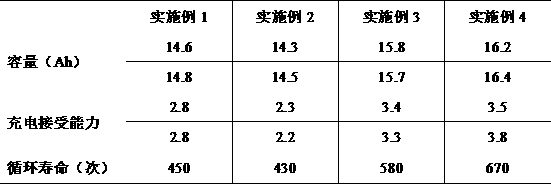Three-dimensional graphene-titanium-based fiber-lead-acid battery negative plate preparation method
A lead-acid battery, graphene technology, applied in lead-acid battery, lead-acid battery construction, battery electrodes and other directions, can solve the problems of complex graphene-based hydrogel process, complicated steps, insufficient performance improvement, etc. Irreversible sulfation phenomenon, improving specific capacity and service life, and enriching the effect of electronic conduction channels
- Summary
- Abstract
- Description
- Claims
- Application Information
AI Technical Summary
Problems solved by technology
Method used
Image
Examples
Embodiment 1)
[0023] Graphene was placed in a mixed solution of concentrated sulfuric acid with a mass fraction of 70% and concentrated nitric acid with a mass fraction of 68%. After washing to neutrality, hydrophilic graphene is obtained after natural air drying.
[0024] The hydrophilic graphene 1.5g obtained after air-drying is dispersed in deionized water, and 15 Kg of lead powder with a particle diameter of 0.5 μm is added to stir and disperse to obtain a graphene-lead powder dispersion.
[0025] The graphene-lead powder dispersion was quickly frozen with liquid nitrogen for 1 min, completely dried, placed in a tube furnace, filled with argon, and heat-treated at 400 °C for 6 h to obtain a graphene-lead powder negative electrode composite with a three-dimensional network structure.
[0026] Add 12 Kg of graphene-lead powder negative electrode composite material with three-dimensional network structure, 37.5 g of acetylene black, 120 g of barium sulfate, 18 g of lignin, 24 g of humic ac...
Embodiment 2)
[0030] Graphene was placed in a mixed solution with a mass fraction of 98% concentrated sulfuric acid and 65% concentrated nitric acid, the volume ratio of concentrated sulfuric acid to concentrated nitric acid was 3:1, refluxed at 80 °C for 4 h, suction filtered, deionized water After washing to neutrality, hydrophilic graphene is obtained after natural air drying.
[0031] The hydrophilic graphene 150g obtained after air-drying is dispersed in deionized water, and 15 Kg of lead powder with a particle diameter of 10 μm is added to stir and disperse to obtain a graphene-lead powder dispersion.
[0032] The graphene-lead powder dispersion was quickly frozen with liquid nitrogen for 5 minutes, completely dried, placed in a tube furnace, filled with argon mixed gas, and heat-treated at 600 °C for 4 hours to obtain a graphene-lead powder negative electrode composite material with a three-dimensional network structure .
[0033] Add 12 Kg of graphene-lead powder negative electrode...
Embodiment 3)
[0037] Graphene was placed in a mixed solution with a mass fraction of 98% concentrated sulfuric acid and 97.5% concentrated nitric acid, the volume ratio of concentrated sulfuric acid to concentrated nitric acid was 4:1, refluxed at 100 °C for 2 h, suction filtered, deionized water After washing to neutrality, hydrophilic graphene is obtained after natural air drying.
[0038] The hydrophilic graphene 60g obtained after air-drying was dispersed in deionized water, and 15 Kg of lead powder with a particle diameter of 20 μm was added to stir and disperse to obtain a graphene-lead powder dispersion.
[0039] The graphene-lead powder dispersion was quickly frozen with liquid nitrogen for 20 min, completely dried, placed in a tube furnace, fed with hydrogen, and heat-treated at 800 °C for 2 h to obtain a graphene-lead powder negative electrode composite with a three-dimensional network structure.
[0040] Add 12 Kg of graphene-lead powder negative electrode composite material with...
PUM
| Property | Measurement | Unit |
|---|---|---|
| particle diameter | aaaaa | aaaaa |
| particle diameter | aaaaa | aaaaa |
| particle diameter | aaaaa | aaaaa |
Abstract
Description
Claims
Application Information
 Login to View More
Login to View More - R&D
- Intellectual Property
- Life Sciences
- Materials
- Tech Scout
- Unparalleled Data Quality
- Higher Quality Content
- 60% Fewer Hallucinations
Browse by: Latest US Patents, China's latest patents, Technical Efficacy Thesaurus, Application Domain, Technology Topic, Popular Technical Reports.
© 2025 PatSnap. All rights reserved.Legal|Privacy policy|Modern Slavery Act Transparency Statement|Sitemap|About US| Contact US: help@patsnap.com

